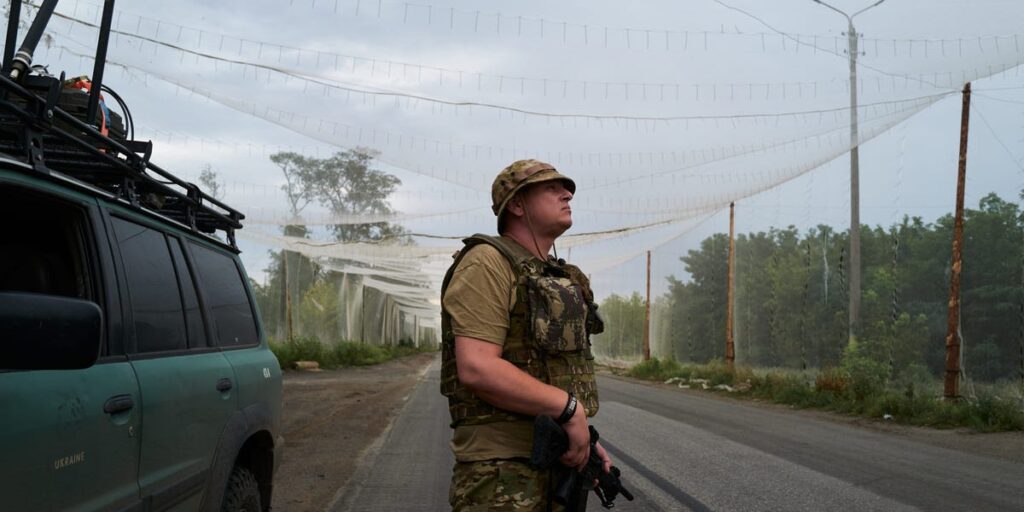Under the constant threat of drone attacks, Ukrainian soldiers have covered many critical roads near the front lines with netting to give themselves a better chance of survival while on the move.
The anti-drone netting — a jury-rigged defense that essentially turns vulnerable supply and logistics routes into protected tunnels — has become an increasingly common tactic, shielding Ukrainian military vehicles from deadly precision drone strikes.
But Russian drone pilots are still finding ways to breach the netting and target Ukrainian soldiers, sometimes even setting traps and waiting for a moment to strike, Business Insider has learned.
Propped up by tall poles positioned along the sides of the roads, the netting became commonplace earlier this summer to prevent Russian drones from targeting key transit routes behind the front lines. Similar to fishing nets, the string catches the drone and its tiny propellers as it homes in on a vehicle.
One video captured from inside a Ukrainian vehicle and reviewed by Business Insider shows two long lines of evenly spaced poles that could be mistaken for telephone poles on the side of a gravel roadway with netting criss-crossing above. Without this defense, the car would have been exposed and extremely vulnerable to hostile drone attacks.
Yevhen Titov/Global Images Ukraine via Getty Images
The netting over the roads is one of the newest ways that Ukraine and Russia are adapting their tactics to the small, cheap, explosive-packed drones that have taken over the battlefield — and become the war’s top killer. Both militaries have also modified their vehicles with similar netting-like protection.
Alex Eine, the section commander for a drone unit with Ukraine’s Separate Presidential Brigade, said the anti-drone netting has spread rapidly, especially in the region that he’s fighting in, which he declined to disclose for security concerns.
Two months ago, only a few areas close to the front lines had been covered by the netting in the region. Now, there’s a whole network of makeshift net tunnels on all the major roads between villages — and even some streets within the villages — 10 kilometers deep behind the front.
Eine said the anti-drone netting has been pretty effective.
In some cases, the netting is the only thing protecting the Ukrainian soldiers from Russia’s fiber-optic drones, which are connected to their pilots by long, thin cables and immune to traditional electronic warfare practices, unlike those drones controlled by radio frequency signals.
The netting isn’t an infallible shield, though. Eine said there are gaps where Russian pilots can maneuver their drones to bypass the defense, although they have to be very skilled to do this.
David Allignon/ZUMA Press Wire
Drones have their limitations. Radio-controlled drones may struggle to fly low enough to pass through the gaps because of the rough terrain and shifts in land elevation that could prevent the pilot from maintaining a clear connection.
And fiber-topic drones are limited by the length and presence of their cables. Eine said this makes it “really rare” for a fiber-optic drone pilot to fly to a road, find a gap, and breach the net.
But Russian pilots are getting through, sometimes landing drones on the side of the road and waiting for Ukrainian vehicles to pass by so they can ambush them. It’s a similar style of attack to the roadside improvised explosive devices that US and partner forces faced regularly in the Middle East, except that this threat can chase down a target.
Eine said this tactic has been observed in his region of fighting, and he’s seen some vehicles destroyed in drone ambushes.
Still, any added protection is better than none at all. The net tunnels underscore just how prominent drone warfare has become in Ukraine, where both militaries are continuing to innovate and make their soldiers, vehicles, and weaponry more survivable.
Kyiv and Moscow have also added cage armor to the exterior of their tanks and military vehicles to give them an added layer of protection from drone attacks. Though once a novelty, it has become very common to see combat vehicles with armor add-ons.



